PDF
Download PDF
Download page Steps in a Bank Failure Analysis.
Steps in a Bank Failure Analysis
The physics described the sections above, computes the FS for a single failure plane. However to determine if the bank will fail and where it will fail several failure planes 1) with different starting elevations on the face of the bank and 2) with different angles have to be evaluated (below).
Therefore, regardless of what method was used to compute the physical FS, the following is a six step iterative evaluation for each bank and time step analyzed:
- Evaluate nodes at several vertical locations up the bank. Then for each node:
- Select the bounding failure planes (minimum and maximum angles) and an initial guess for FScr
- Compute the FSi
- Use that information to select a more likely critical failure plane (using the "bracket and Brent" optimization algorithm from Teukolsky et al. (2007)) (setting FSi+1 to a new estimate of FScr)
- Decide when FS is close enough to FScr to stop, otherwise repeat Step 3
- Select the FScr for all nodes and if FScr is less than one, fail the bank, update the cross section, and send the bank sediments to the routing model
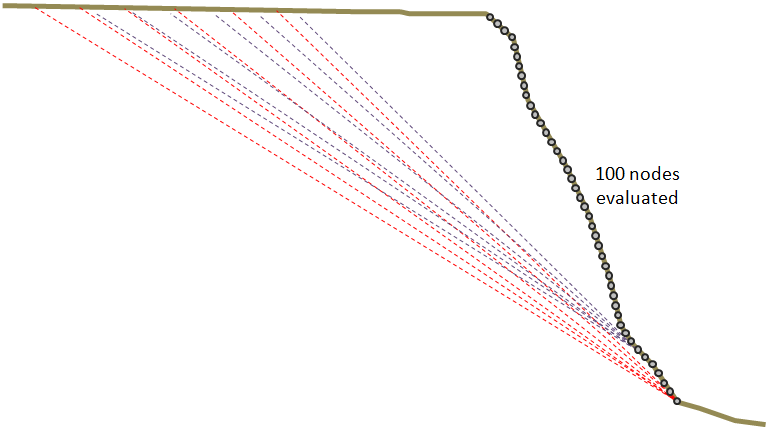
The following describes the above steps in more depth.
- Evaluate nodes at several vertical locations up the bank
The software will find a critical failure plane that starts at several vertical locations along the face of the bank. HEC-RAS evaluates 100 points which are evenly spaced vertically between the user specified toe and top of bank (one percent evaluation intervals) by default. Fewer evaluation points can be specified under BSTEM to improve run time. However, bank points that are evenly spaced will not be evenly spaced along an irregular bank.
For each elevation, the bank failure algorithms will find a critical FS failure plane. Instead of running many angles for each node at very small increments, a minimization algorithm with quadratic convergence (bracket and Brent) is used to find the failure plane with the minimum FS at each node with as few failure planes as possible. This process includes the next Steps. - Select the bounding failure planes (minim and maximum angles) and compute a FS for each
The first step of finding the critical FS of a given bank node is to bound the possible angles (the "bracket" in bracket and Brent). The minimum angle is set to half of the friction angle, which is a reasonable angle below which most bank configurations would be expected to remain stable. The maximum angle is the largest angle that is entirely in the soil matrix (below).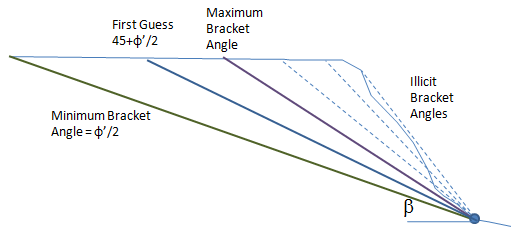
Then the bank failure method makes an initial guess for the critical failure plane to start the parabolic search, which is 45degrees plus half the friction angle.
However, sometimes it is not as simple as the classical configuration in the figure above. A number of unique configurations posed by natural channel banks can cause the default maximum angle to be less than half the friction angle or can generate an initial guess '45o+Φ'/2) to fall outside of the bracket among other complications. Therefore, there are special cases to deal with unique configurations.
With the maximum and minimum angles set and a first estimate established, the bank failure algorithm is prepared to start the iterative search to determine a critical failure plane angle.
In the initial iteration, an FS is computed for the maximum, minimum, and initial estimate failure plane angles by the methods described above (below). In each successive iteration, an FS is computed for the new failure plane angle selected by the parabolic search.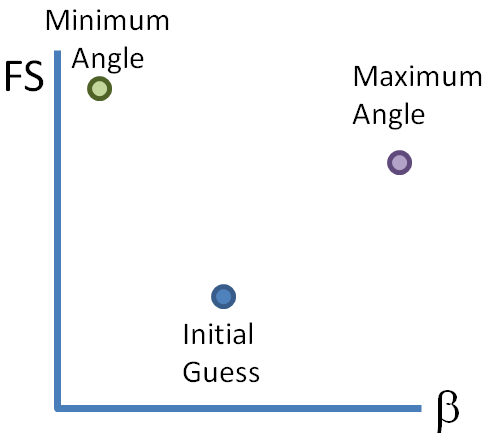
FS is computed for the maximum, minimum and best guess angles with the physics described above, and then the three angle-FS pairs are passed to the bracket and Brent (Teukolsky et al. 2007) routine, which fits a parabola to the FSs associated with the three angles and then iterates to find the minimum. With each iteration, the bracket shrinks (the maximum and minimum possible angles converge) and the algorithm completes when the bracket drops below 0.5 deg. - Compute FSi
The algorithm computes an FS for the βi selected by the methods described in detail ab - Use that information to select a more likely critical failure plane
Next HEC-RAS uses a parabolic optimization algorithm (bracket and Brent) to find an angle (β) that is likely to have a lower FS. The software fits a second order quadratic equation through the three factors of β - FS points and identifies the angle (βi in figure (a) below) associated with the parabolic minimum.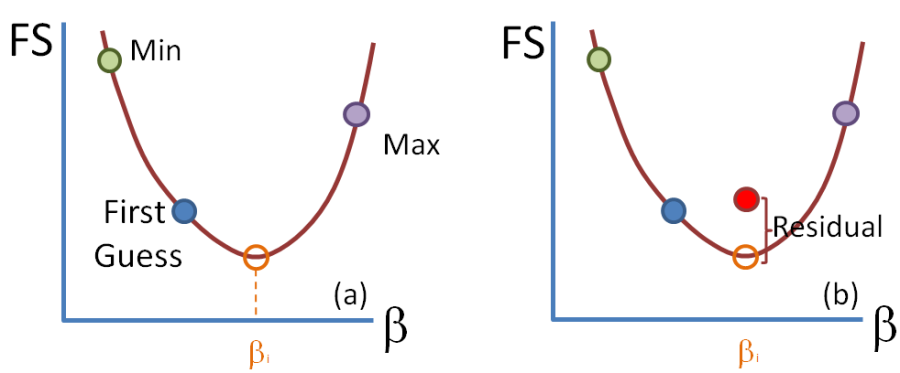
- Decide when the FS is close enough to FScr to stop, otherwise Iterate
The actual relationship between βi and FS does not necessarily fit a second order quadratic equation. Therefore, the FS computed for the angle selected (βi) will not precisely match that predicted by the function. Therefore, the bank failure algorithm evaluates the difference between the computed FS and the predicted FS ("residual" in figure b above). If the difference is less than half a percent (i.e., residual less than 0.5 percent) then the parabolic function is considered a good approximation of the β-FS relationship and the βi is adopted as the critical failure plane for this bank node.
However, if the residual is greater than 0.5 percent, the algorithm will iterate and return to Step 3, by trying to identify the most likely critical failure plane angle given the new information. The new βi - FSi point becomes the new maximum or minimum (depending on which side the last βi is on) and a new, narrower, second order quadratic is fit to the new three points (below). A new βi+1 is selected at the minimum of the function. The FS is calculated (Step 4) and the residual evaluated (Step 5). As this algorithm iterates the range between the maximum and the minimum shrinks as the function converges (usually within a few iterations) to a solution.
However, sometimes β - FS functions that depart substantially from the parabolic model can return false, local minimums. For example, the theoretical function in "Monotonic β- FS function associated with a cantilever curve" (a) passes through the same points as (b) below but would not be predicted by the "narrowing parabolic" method. Therefore, the iteration optimization includes occasional searches to find other β regions with low FSs.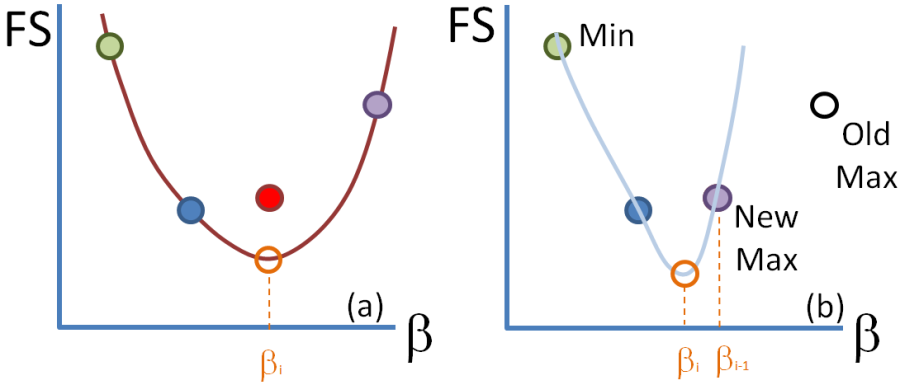
Additionally, sometimes the relationship between β and FS is monotonic (graph b below). This occurs in the case of cantilever failures where the highest factor of safety is often associated with the maximum angle. If the maximum angle is has the lowest factor of safety in Step 2, this is automatically accepted as the critical failure plane and the model does not iterate.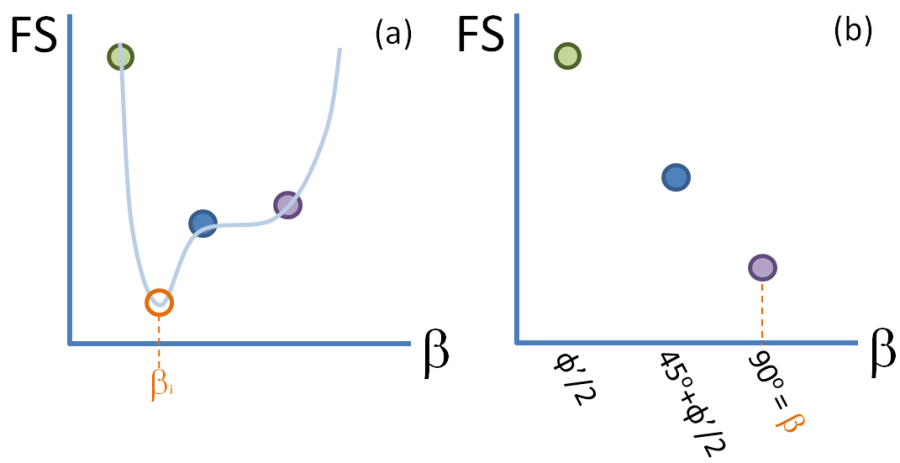
- Select the FScr for all nodes and if FScr is less than one, fail the bank, update the cross section, and send the bank sediments to the routing model
Finally, after the critical failure plane is iteratively computed for each of the vertical evaluation points on the bank, the failure plane with the lowest overall failure plane is selected. If the FS is greater than one, the bank is stable. However, if the FS is less than one, then the bank fails and the bank material inside of the failure plane is removed from the bank and added to the control volume of the sediment routing model associated with the cross section. The material inside of the failure plane is removed, the cross section is updated, and the material is introduced into the sediment routing model as a lateral load.